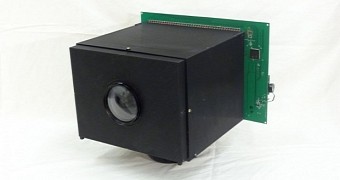In a report released just yesterday, April 15, researchers at Columbia University School of Engineering and Applied Sciences describe a futuristic camera that powers itself and can therefore run indefinitely without ever needing a battery.
The camera, shown in the photo accompanying this article, doesn't look like much. Some might even mistake it for the ancestor of the high-tech devices guys and gals these days use to snap selfies.
Still, the Columbia University team who created it say that, not-so-appealing design aside, the camera counts as a technological breakthrough. After all, how many of our gadgets and gizmos can keep themselves alive indefinitely without a battery?
Anatomically-wise, the camera resembles a solar panel
In the paper detailing their work, researcher Shree K. Nayar and colleagues explain that, anatomically-wise, the self-powered video camera they created is not all that different from a solar panel.
The scientists say that, although they serve different purposes, digital cameras and solar panels have devices known as photodiodes at their core. These devices serve to convert light into electrical current.
In the case of digital cameras, photodiodes enable the pixels that form their image sensor to accurately read the intensity of the light reaching them. In the case of solar panels, the photodiodes, well, turn incident light into electrical power.
Because they have different working agendas, the photodiodes in cameras and in solar panels are referred to as being used in photoconductive mode and photovoltaic mode, respectively.
Unlike the photodiodes in run-of-the-mill cameras, the ones in the self-powered one developed by the Columbia University team both help measure light intensity and convert light into electrical power. Hence the fact that the camera needs no battery.
“During each image capture cycle, the pixels are used first to record and read out the image and then to harvest energy and charge the sensor’s power supply,” the scientists explain.
Even cooler, Shree K. Nayar and his team say that, when not used to record any images, the camera can double as a power source for other devices such as a phone or a watch. It can even inject power into a rechargeable battery.
The researchers have ambitious plans for the future
The Columbia University scientists say that, to their knowledge, this self-powered camera that they designed and develop is the absolute first of its kind anywhere in the world.
The researchers plan to continue perfecting it and hope that their work will pave the way for the development of a new generation of cameras and other such devices that don't require an external power source to keep up and running.
“We believe our results are a significant step forward in developing an entirely new generation of cameras that can function for a very long duration, ideally forever, without being externally powered,” says specialist Shree K. Nayar.

 14 DAY TRIAL //
14 DAY TRIAL //